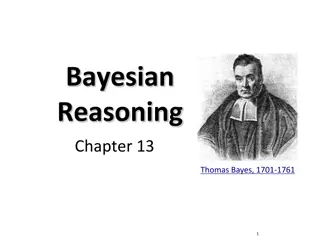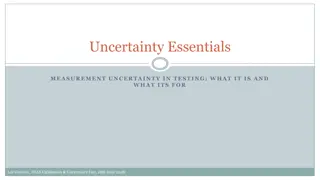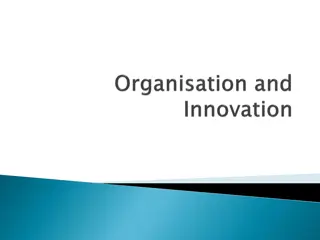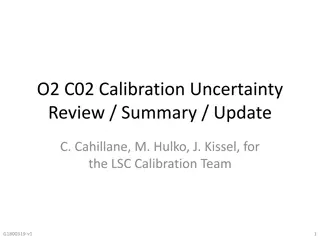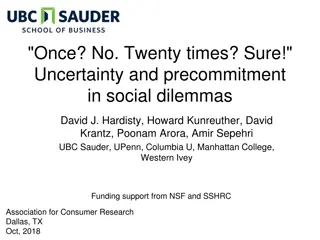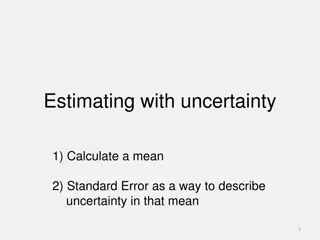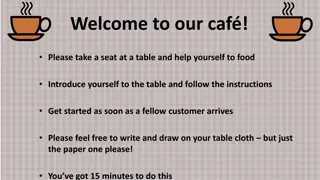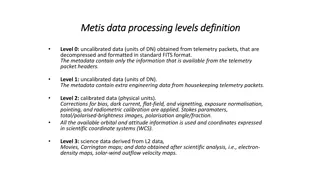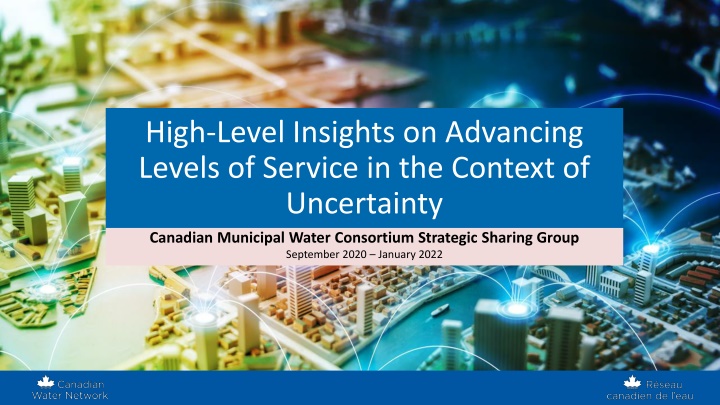
Advancing Levels of Service in Municipal Water Management
Explore key themes like cross-departmental collaboration, data management, and financial sustainability for enhancing water service levels in Canadian municipalities. Discover strategies to break organizational silos and improve employee engagement.
Download Presentation

Please find below an Image/Link to download the presentation.
The content on the website is provided AS IS for your information and personal use only. It may not be sold, licensed, or shared on other websites without obtaining consent from the author. If you encounter any issues during the download, it is possible that the publisher has removed the file from their server.
You are allowed to download the files provided on this website for personal or commercial use, subject to the condition that they are used lawfully. All files are the property of their respective owners.
The content on the website is provided AS IS for your information and personal use only. It may not be sold, licensed, or shared on other websites without obtaining consent from the author.
E N D
Presentation Transcript
High-Level Insights on Advancing Levels of Service in the Context of Uncertainty Canadian Municipal Water Consortium Strategic Sharing Group September 2020 January 2022
Overarching Themes 1. Cross-Departmental and Cross-Sectoral Collaboration, Coordination, and Internal Engagement 2. Customer, Public, Council and Board Awareness and Engagement 3. Data Collection, Storage, Tracking, Management, Accessibility and Use 4. Water Equity and Affordability 5. Sustainably Financing Levels of Service
Cross Cross- -Departmental and Cross Departmental and Cross- -Sectoral Collaboration, Coordination, and Internal Engagement Sectoral Collaboration, Coordination, and Internal Engagement Successfully embracing a culture of levels of service line of sight between organizational purpose and performance measures. culture of levels of service across the organization requires creating a Crossing organizational silos Crossing organizational silos is critical in creating a common understanding across the utility and identifying important links between technical, corporate and customer levels of service. Collaborating across departments Collaborating across departments for data management, analysis, resources and planning can help reduce the transfer of information help reduce the transfer of information. . It can also create more direct data collection and input, leading to more effective planning and prioritization processes. leading to more effective planning and prioritization processes. can Regular and consistent, cross Regular and consistent, cross- -departmental collaboration and employee engagement departmental collaboration and employee engagement are essential to effectively move forward with levels of service development. Successfully embracing a culture line of sight between organizational purpose and performance measures and taking a top-down and bottom-up approach. culture of of levels levels of of service service across the organization requires creating a
Cross Cross- -Departmental and Cross Departmental and Cross- -Sectoral Collaboration, Coordination, and Internal Engagement Sectoral Collaboration, Coordination, and Internal Engagement Crossing Crossing organizational organizational silos across the utility and identifying important links between technical, corporate and customer service levels. silos is critical in creating a common understanding of levels of service Regular Regular and essential to effectively move forward with levels of service development. and consistent, consistent, cross cross- -departmental departmental collaboration collaboration and and employee employee engagement engagement are Potential Strategies Potential Strategies Ensure there is a voice at the table from every department when deciding on the direction and scope of corporate actions. Collaborate across departments Collaborate across departments for data management, analysis, resources and planning. It can help reduce the transfer of information help reduce the transfer of information and create more direct data collection and input, leading to more effective planning and prioritization processes. to more effective planning and prioritization processes. This can be approached by bringing departments together at the corporate level to collectively address the culture before breaking into smaller service groups to balance priorities. It can leading
Customer, Public, Council and Board Awareness and Engagement Customer, Public, Council and Board Awareness and Engagement Effective customer consultation, public engagement and messaging are critical Effective customer consultation, public engagement and messaging are critical tools for engaging with internal and external stakeholders. This engagement can help build more meaningful and relatable customer, corporate and technical levels of service. Because most infrastructure is below ground, building public awareness and understanding of critical water, wastewater and stormwater systems is an important first step critical water, wastewater and stormwater systems is an important first step for enhancing a utility s ability to shape meaningful and relatable customer levels of service. building public awareness and understanding of Whether the customer is residential, business or municipal, communication initiatives are most effective when effective when implemented after implemented after the utility has set the context through public awareness the utility has set the context through public awareness campaigns campaigns. communication initiatives are most Developing and delivering appropriate messaging Developing and delivering appropriate messaging for different stakeholders is critical to building awareness and generating support. However, effectively accomplishing this remains a challenge many utilities are still faced with.
Customer, Public, Council and Board Awareness and Engagement Customer, Public, Council and Board Awareness and Engagement Integrating the needs and expectations of the customer into the business culture Integrating the needs and expectations of the customer into the business culture is a critical action that can help: 1. Develop trust in the utility. 2. Underscore value for money. 3. Identify how people are perceiving services. 4. Highlight opportunities to work more efficiently and effectively. 5. Emphasize the importance of addressing pre-existing assumptions in order to manage issues. Identifying what is important to the customer by including the customer voice in performance Identifying what is important to the customer by including the customer voice in performance metrics metrics can help ensure the utility consistently meets expectations can help ensure the utility consistently meets expectations.
Customer, Public, Council and Board Awareness and Engagement Customer, Public, Council and Board Awareness and Engagement Including the customer voice in performance metrics starts with a better understanding of the Including the customer voice in performance metrics starts with a better understanding of the customer and ensuring customer and ensuring that performance measures resonate more clearly with what the that performance measures resonate more clearly with what the customer wants and expects customer wants and expects. A performance measure might indicate Reliable Service Delivery. However, to better understand what this means to the customer, identifying the expectation tied to this performance measure through the customer s voice can help create greater clarity. For example, in the customer s eyes, reliable service delivery could mean water is always there when I turn on the tap. Subsequently, it is important to understand the customer s tolerance if this expectation is not it is important to understand the customer s tolerance if this expectation is not met. This is so the value of and trust in the utility is not eroded. met. This is so the value of and trust in the utility is not eroded. Transforming corporate and technical levels of service Transforming corporate and technical levels of service across all departments into goals and targets that reflect what customers want and need can result in more appropriate levels of service that resonate.
Customer, Public, Council and Board Awareness and Engagement Customer, Public, Council and Board Awareness and Engagement Deepening understanding of diverse customer segments is critical to successfully advancing levels of service that resonate with the customer. Once a utility understands who its customer is, it can begin to explore the right engagement strategies that yield key customer insights. Potential Strategies Potential Strategies A number of strategies can be adopted in an effort to include the customer voice in performance metrics. Empathy exercises, service reviews, experience statements, journey Empathy exercises, service reviews, experience statements, journey mapping, customer data mapping, customer data (from customer service phone calls and surveys), and focus groups are some examples of exercises that can help the utility better understand their customer some examples of exercises that can help the utility better understand their customer and subsequently improve efficiency of service delivery. and focus groups are Building public awareness can be achieved through public communication initiatives, awareness campaigns, and developing effective and consistent messaging campaigns, and developing effective and consistent messaging around issues concerning municipal water management and operations. public communication initiatives, awareness
Data Collection, Storage, Tracking, Management, Accessibility and Use Data Collection, Storage, Tracking, Management, Accessibility and Use Many utilities/municipalities continue to experience challenges in quantifying current levels of service service. This presents a challenge to setting appropriate service level targets for the future. challenges in quantifying current levels of Many participants agree that data is an important asset that can help bring clarity to roles and responsibilities across the organization, however, there remain very few utilities that formally recognize data as a corporate asset. recognize data as a corporate asset. there remain very few utilities that formally Data governance remains an area in which most participating utilities and municipalities are in the early stages. Having a governance structure or framework has been highlighted as essential Having a governance structure or framework has been highlighted as essential to effectively moving levels of service forward. to effectively moving levels of service forward. Participating municipalities agree that good quality data is needed in order to drive effective quality data is needed in order to drive effective levels of service decision levels of service decision- -making. making. Currently, many utilities are challenged by ensuring the data they are collecting is not only good quality but that it can be used effectively.
Data Collection, Storage, Tracking, Management, Accessibility and Use Data Collection, Storage, Tracking, Management, Accessibility and Use The struggle to collect good quality data versus higher volumes of data is a challenge struggle to collect good quality data versus higher volumes of data is a challenge that municipalities and utilities across Canada face. This is particularly true in the context of rapid growth and development and can create financial, work planning, capacity, maintenance and can create financial, work planning, capacity, maintenance and planning challenges planning challenges. Corrective maintenance is the current norm across the water sector but can often result in Corrective maintenance is the current norm across the water sector but can often result in overworked staff and employee burnout. overworked staff and employee burnout. Having resources in the right place to make proactive decisions for the long term can help utilities operate more effectively. Although all participants highlighted their data collection efforts across multiple categories (e.g. GIS, hydrology, SCADA, finance, customer etc.), many reiterated that integrated, cross- department collaboration, consultation and coordination that directly informs levels of service is still very much in the early stages. Because data is oftentimes collected in silos, standardized Because data is oftentimes collected in silos, standardized collection, organization, access, analysis, and ability to effectively use data to drive cross collection, organization, access, analysis, and ability to effectively use data to drive cross- -cutting utility utility- -wide decision wide decision- -making remains a work in progress making remains a work in progress. cutting
Data Collection, Storage, Tracking, Management, Accessibility and Use Data Collection, Storage, Tracking, Management, Accessibility and Use Potential Strategies Potential Strategies Understanding whether data collected is fit for purpose and can be used to inform decisions can be a challenge without the right processes in place. Conducting gap analyses and assessing workflow processes can help identify weaknesses in data and daylight opportunities for more effective data collection. Prioritization planning and adopting a phased approach can support continuous and sustainable improvement. Create a data framework to gain a better understanding of different demographic attributes of service area census tracts (e.g. Equity Index map). For example, Xylem Inc. uses payment behaviour to drive customer segmentation then overlays demographic trends to identify correlation.
Water Equity and Affordability Water Equity and Affordability Lack of municipal/utility movement on the affordability discussion results from a lack of clarity on levels of service and understanding current performance. Participants note there is often a lack of visibility within a utility of how programs and lack of visibility within a utility of how programs and infrastructure investments are distributed across a utility s service area. infrastructure investments are distributed across a utility s service area. For example, poorer areas of the city often have lower levels of services. The COVID The COVID- -19 pandemic has brought many inequities to the forefront. 19 pandemic has brought many inequities to the forefront. Many programs do not always target the communities or stakeholders that are most often underrepresented. Many municipalities expect a cultural shift that will prioritize integrating equity practices across utility approaches and ensure broader engagement with all stakeholders. One of the many challenges in the equity discussion is ensuring that historically underrepresented stakeholders have opportunities to share their experiences to help build underrepresented stakeholders have opportunities to share their experiences to help build effective equity practices. effective equity practices. This includes evaluating how programs, incentives and subsidies are received and ensuring they can be accessed equitably by the people who need them. ensuring that historically
Water Equity and Affordability Water Equity and Affordability Potential Strategies Potential Strategies Develop a spatially explicit set of water equity indicators using data. For example, Xylem inc. has created indicators to evaluate the historical and predictive rates of water main breaks, sewer overflows, water quality, shut-offs, lead service lines and private property flooding trends. This can help determine not only where low service hot spots are, but what the utility is doing to address this issue and where investment would have the greatest impact. Collect disaggregated data to identify natural trends.
Sustainably Financing Levels of Service Sustainably Financing Levels of Service Finding the political will and public/council support to finance appropriate levels of service in the near and long-term is essential, but also a key challenge for many municipalities. Since most water infrastructure is buried, there is a disconnect between public awareness and water utility services. Aligning levels of service with long Aligning levels of service with long- -term financial planning is critical in assessing the value of term financial planning is critical in assessing the value of investments and identifying gaps. investments and identifying gaps. Many municipalities struggle to justify the capital investment required municipalities struggle to justify the capital investment required for necessary upgrades/improvements to maintain or establish levels of service. Most water, wastewater and stormwater utilities across Canada prioritize keeping assets in a state-of-good-repair. As such, competing priorities within the utility present challenges for fairly competing priorities within the utility present challenges for fairly allocating staff time, capacity and resources allocating staff time, capacity and resources.
Sustainably Financing Levels of Service Sustainably Financing Levels of Service Finding a balance between assets, financials, operations and customer expectations is critical to sustainable utility management. This is especially important in the context of changing customer expectations and competing priorities. The COVID COVID- -19 pandemic has resulted in a shift in expenditures and employee capacity 19 pandemic has resulted in a shift in expenditures and employee capacity. Some municipalities are challenged with finding the resources to respond to the pandemic while simultaneously committing resources to advance other vital initiatives. Potential Strategies Potential Strategies Some utilities use an approach of aligning utility priorities with the municipal plans (e.g. Climate Action Plans, Asset Management Plans, Long-Term Financial Plans, etc.). Initiatives implemented may not always remain the top priority as other emerging issues (e.g. wildfires, ice storms, etc.). So, to compensate for this, a utility can ensure it uses similar and aligned frameworks as the other programs/services it might compete with.
CWN Strategic Sharing Groups Unique and meaningful peer Unique and meaningful peer- -to to- -peer sharing opportunities on emerging strategic issues. emerging strategic issues. Environment for confidential dialogue among participating Environment for confidential dialogue among participating senior municipal/utility managers. senior municipal/utility managers. Leading experts to share their knowledge. Leading experts to share their knowledge. Deep dive discussions on topics directed by the group. Deep dive discussions on topics directed by the group. Critical takeaways used to shape future Consortium initiatives. Critical takeaways used to shape future Consortium initiatives. peer sharing opportunities on


